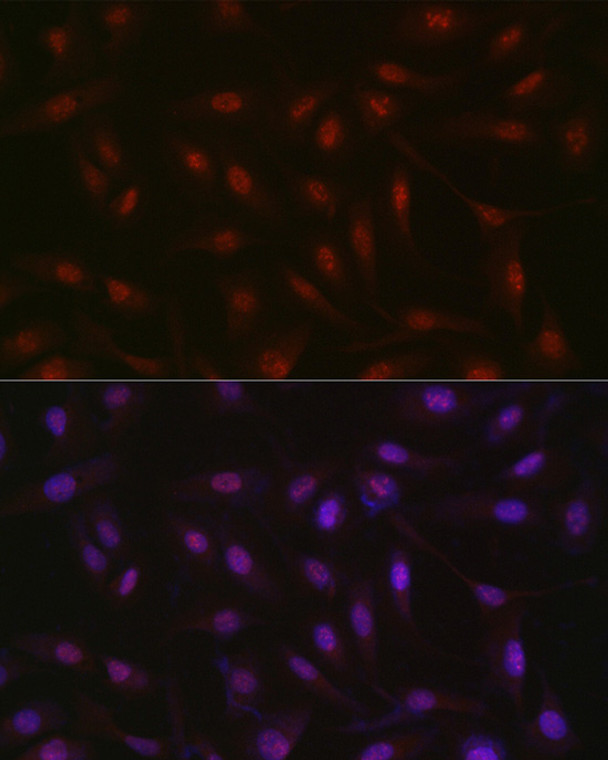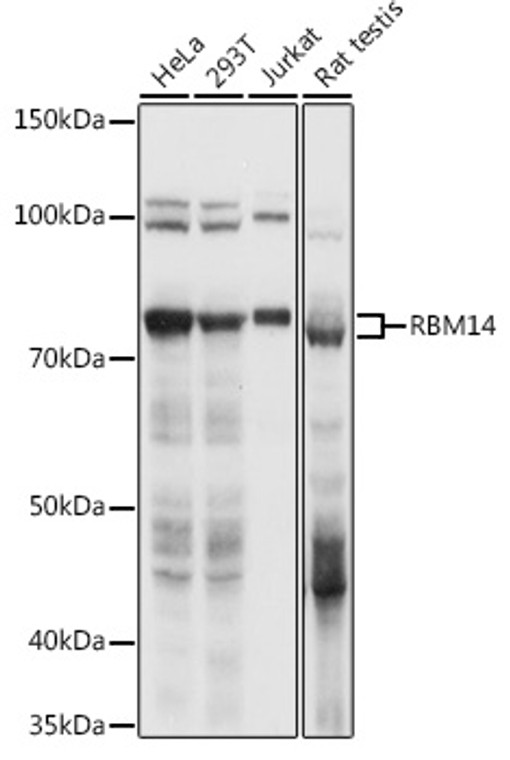| Host: |
Rabbit |
| Applications: |
WB/IF |
| Reactivity: |
Human/Mouse/Rat |
| Note: |
STRICTLY FOR FURTHER SCIENTIFIC RESEARCH USE ONLY (RUO). MUST NOT TO BE USED IN DIAGNOSTIC OR THERAPEUTIC APPLICATIONS. |
| Short Description: |
Rabbit polyclonal antibody anti-RBM14 (110-220) is suitable for use in Western Blot and Immunofluorescence research applications. |
| Clonality: |
Polyclonal |
| Conjugation: |
Unconjugated |
| Isotype: |
IgG |
| Formulation: |
PBS with 0.01% Thimerosal, 50% Glycerol, pH7.3. |
| Purification: |
Affinity purification |
| Dilution Range: |
WB 1:500-1:1000IF/ICC 1:100-1:500 |
| Storage Instruction: |
Store at-20°C for up to 1 year from the date of receipt, and avoid repeat freeze-thaw cycles. |
| Gene Symbol: |
RBM14 |
| Gene ID: |
100526737/10432 |
| Uniprot ID: |
RBM14_HUMAN |
| Immunogen Region: |
110-220 |
| Immunogen: |
Recombinant fusion protein containing a sequence corresponding to amino acids 110-220 of human RBM14 (NP_006319.1). |
| Immunogen Sequence: |
VVKDYAFVHMEKEADAKAAI AQLNGKEVKGKRINVELSTK GQKKGPGLAVQSGDKTKKPG AGDTAFPGTGGFSATFDYQQ AFGNSTGGFDGQARQPTPPF FGRDRSPLRRS |
| Tissue Specificity | Expressed in all tissues tested, including brain, heart, skeletal muscle, colon, thymus, spleen, kidney, liver, small intestine, placenta, lung and peripheral blood lymphocytes. |
| Function | Isoform 1 may function as a nuclear receptor coactivator, enhancing transcription through other coactivators such as NCOA6 and CITED1. Isoform 2, functions as a transcriptional repressor, modulating transcriptional activities of coactivators including isoform 1, NCOA6 and CITED1. Regulates centriole biogenesis by suppressing the formation of aberrant centriolar protein complexes in the cytoplasm and thus preserving mitotic spindle integrity. Prevents the formation of the STIL-CENPJ complex (which can induce the formation of aberrant centriolar protein complexes) by interfering with the interaction of STIL with CENPJ. Plays a role in the regulation of DNA virus-mediated innate immune response by assembling into the HDP-RNP complex, a complex that serves as a platform for IRF3 phosphorylation and subsequent innate immune response activation through the cGAS-STING pathway. |
| Protein Name | Rna-Binding Protein 14Paraspeckle Protein 2Psp2Rna-Binding Motif Protein 14Rrm-Containing Coactivator Activator/ModulatorSynaptotagmin-Interacting ProteinSyt-Interacting Protein |
| Database Links | Reactome: R-HSA-8941326 |
| Cellular Localisation | NucleusNucleolusCytoplasmIn Punctate Subnuclear Structures Often Located Adjacent To Splicing SpecklesCalled ParaspecklesCytoplasmic Localization Is Crucial For Its Function In Suppressing The Formation Of Aberrant Centriolar Protein Complexes |
| Alternative Antibody Names | Anti-Rna-Binding Protein 14 antibodyAnti-Paraspeckle Protein 2 antibodyAnti-Psp2 antibodyAnti-Rna-Binding Motif Protein 14 antibodyAnti-Rrm-Containing Coactivator Activator/Modulator antibodyAnti-Synaptotagmin-Interacting Protein antibodyAnti-Syt-Interacting Protein antibodyAnti-RBM14 antibodyAnti-SIP antibody |
Information sourced from Uniprot.org
12 months for antibodies. 6 months for ELISA Kits. Please see website T&Cs for further guidance









